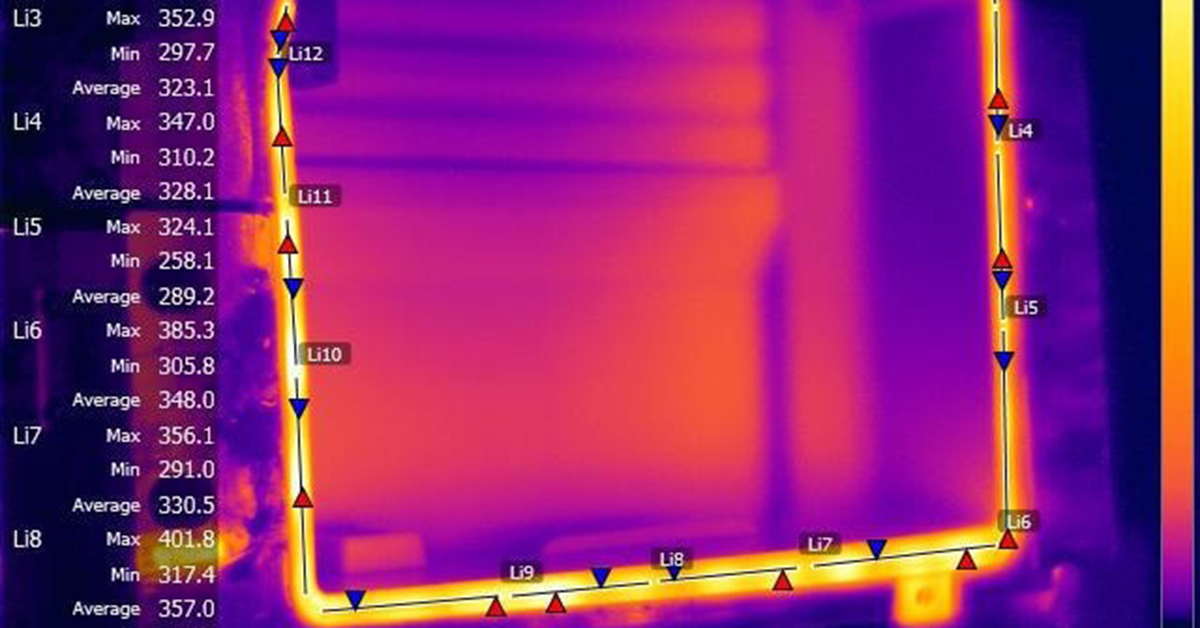FLIR cameras support analysis and diagnosis of external thermal insulation systems
External thermal insulation systems have become increasingly important in the European construction marketplace. Encouraged by increasingly stringent energy certification requirements and energy efficiency regulations for buildings, constructors are paying more attention to efficient placement of these systems. Unfortunately, many square meters of external thermal insulation systems on new or existing buildings have been installed without using the best practices. In order to better understand anomalies in insulation installations as well as the thermal characteristics of these insulation products, a consortium of companies, including the Italian Association for Thermal and Acoustic Insulation (ANIT), carried out a research project, with the help of thermal imaging cameras from FLIR Systems.
A study aimed at recognizing anomalies in insulation systems and their installation was carried out by ANIT and two member companies of this organization, viz. Caparol, and FLIR Systems. The study was coordinated by Tep srl, an engineering services firm focusing on non-destructive energy efficiency tests for buildings.
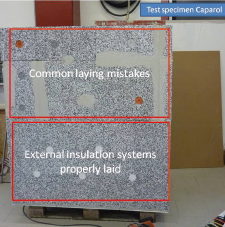
Building a test specimen
To study the thermal phenomena characterizing the installation of external thermal insulation systems, a test specimen was built and covered on three sides with thermal insulation panels (EPS with graphite additive). In the top portion of the specimen, the walls were covered by making common laying mistakes, while the bottom portion was properly laid, with and without EPS dowels.
Active thermography analysis
A dummy wall was monitored and analyzed during a charging and discharging solar cycle and periodic thermal images were recorded and stored. With active thermography, charging is done by solar radiation impacting the test specimen’s surface. During the discharge phase the structure that has accumulated energy is then monitored as it releases the energy when in the shade. For this test, ANIT opted for the FLIR T640 thermal imaging camera, which proved to be the best fit for the job.
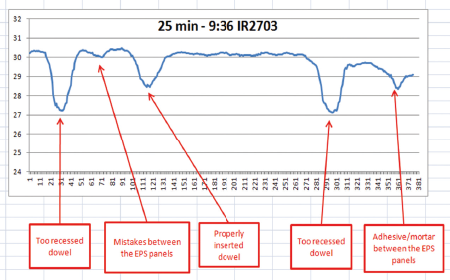
Heat transmission in variable conditions
To properly analyze what happened in the various cases highlighted by the thermographic analysis and to understand possible laying anomalies, the basics of heat transfer in variable conditions on the surface of the insulation need to be understood.
In heat transfer under variable conditions (i.e. with variable surface temperatures) the thermal resistance, the conductivity and the thickness of each material are not sufficient to define the thermal behavior of the various layers. In fact, the density and specific heat of the materials must also be considered. The parameter that characterizes the materials under variable conditions linked to surface radiation of a structure with external thermal insulation is called thermal effusivity.
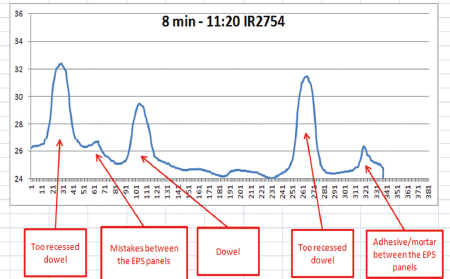
Thermal effusivity is a measure of a material's thermal energy penetration ability: the surface temperature of the external thermal insulation subjected to solar radiation is strongly influenced by how the material from the surface level conducts heat in the material's sub-layers combined with the material's capacity to accumulate heat and therefore to warm up. Effusivity in this context expresses how easily the material is heated inside by solar radiation: the lower its value is, the lower the amount of energy required to heat the material.
The test specimen consists of several materials with different thermal effusivity values: adhesive (eff.=906), EPS with graphite additive (eff.=27) and PVC - of the dowels (eff.=530).
Analysis of the test specimen
Analysis of the characteristics of the materials shows the different behavior in terms of energy charging caused by radiation and the subsequent discharging due to shading.
a) When subject to solar radiation the stimulation will warm the surface. The PVC and the adhesive, have a greater effusivity than EPS, so they will initially be colder than the EPS and the EPS will warm more easily. The dowels and adhesive joints will be the coldest points.
b) Then the test specimen is cooled down in the shade. The PVC and adhesive have a greater volumetric heat capacity, so they have accumulated more thermal energy and therefore will be initially hotter than the EPS. The EPS material will cool down more rapidly; the dowels and the adhesive joints will be hottest points.
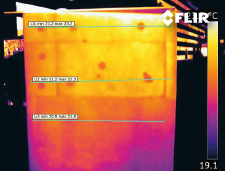
A temperature graph presenting the upper part of the specimen shows that there’s insulating material with low thermal conductivity and limited thermal capacity and the adhesive and the PVC dowels which have high thermal conductivity and greater heat capacity. Given the energy stored as a result of solar radiation the insulation cools faster because the amount of stored energy is smaller i.e. it has a smaller volumetric heat capacity.
The thermal analysis makes clear that there are two distinct types of surface layers: the insulating material with low thermal conductivity and limited thermal capacity and the adhesive and the PVC dowels which have higher thermal conductivity and greater heat capacity. While performing thermographic analysis, the thermographer must be aware of what is identified as a surface anomaly: it is necessary to understand the external thermal insulation system and what, as observed under proper environmental conditions, can be considered a defect.
FLIR T640bx camera
ANIT opted for the FLIR T640bx because of a variety of technical requirements. The specimen study required the possibility to investigate temperature gaps near 0.5 °C and to record and control superficial temperature variations automatically during different time lapses. The camera also needed to be able to generate quality video images that could testify the active study of the surface thermal behavior.
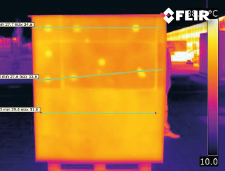
The FLIR T640bx camera succeeded with flying colors. The T640bx is a high-performance thermal imaging camera with on-board 5MP visual camera, interchangeable lens options, auto-focus, and large 4.3" touchscreen LCD. It combines excellent ergonomics with superior image quality, providing the ultimate image clarity and accuracy plus extensive communication possibilities.

